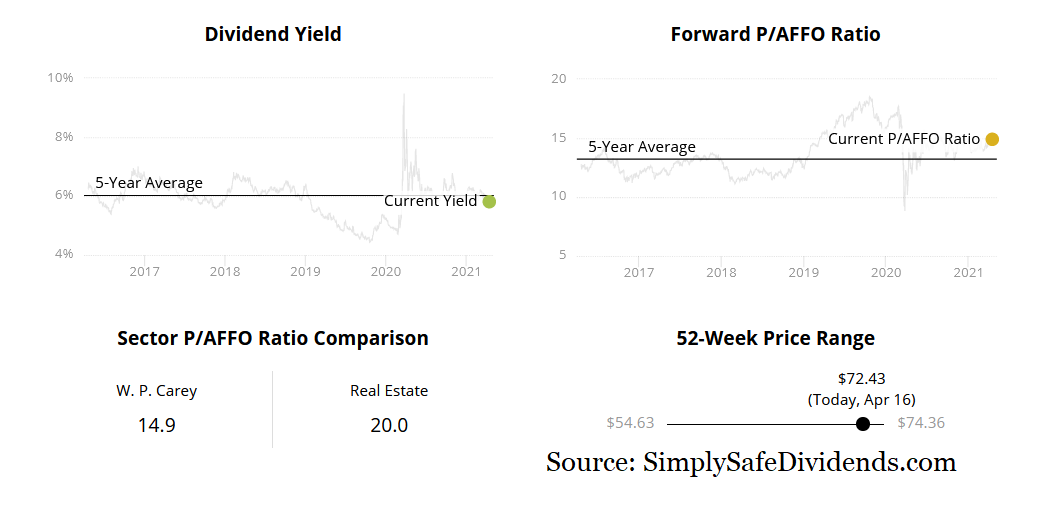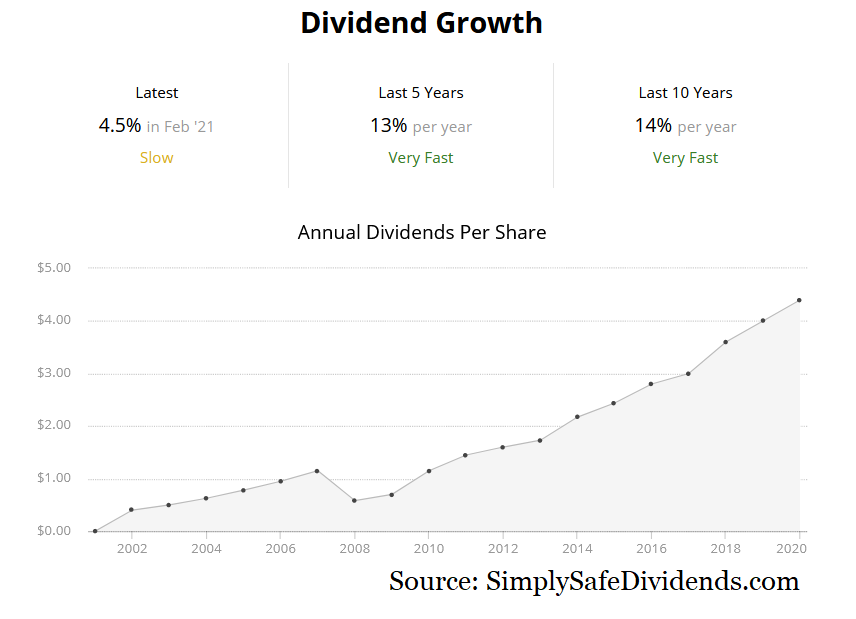This is the fourth article in our series covering investors of different ages. We already published articles discussing stocks to buy for investors in their 20s, 30s, and 40s.
And now I’m talking to investors in their 50s.
As someone who started investing in his 20s, is now in his 30s, and is transitioning into his 40s pretty soon, I’ve seen my own investment views and needs change over time.
As you get older, you start to deprioritize growth. And you start to prioritize things like safety, quality, and income. When you’re in your 50s, you have a lot less time to make up for losses. You can take a big risk on some high-flying, expensive stock in your 20s. If it blows up, no big deal. You’ve got time. But time becomes less of a luxury as you get older.
Plus, as you start to glide into your retirement years, income becomes so important. You want to build up a gaggle of golden geese laying large, safe, growing golden eggs. Because if you have a bunch of stocks that don’t offer enough income via yield, you might have to sell off your stocks to produce income. And that puts you at risk of running out of geese to slaughter.
It’s with this in mind I want to share with you three different high-quality dividend growth stocks to consider buying if you’re in your 50s.
These stocks offer yields up to four times higher than the broader market’s yield. And these dividends are very safe and growing at inflation-beating rates, which allows you to keep up with the rising costs of life.
Want to know which stocks I’m talking about? Let’s dig in.
Quinquagenarian Stock #1: W.P. Carey (WPC)
The first stock I want to share with you is W.P. Carey (WPC).
W.P. Carey is a global real estate investment trust that owns and manages over 1,000 different properties.
There’s plenty of money to be made in real estate. But there are also plenty of headaches to be had in real estate. W.P. Carey does both for you so that you don’t have to.
Speaking of making money, this stock yields a whopping 5.9%.
That’s about four times higher than what you’d get with the broader market. And it’s safe, too. The company is expecting to earn $4.86 in AFFO/share at the midpoint this fiscal year, easily covering their dividend that runs just under $4.20 annually.
Plus, this is almost a Dividend Aristocrat, with 24 consecutive years of dividend increases.
If the dividend weren’t safe, it wouldn’t have grown for 24 straight years. And while the five-year dividend growth rate of 1.7% won’t knock your socks off, it should allow your purchasing power to remain intact. It’s a healthy golden goose laying very large golden eggs. And it’s laying slightly more golden eggs every year. Gotta love it.
Also, the stock looks inexpensive here.
Using that aforementioned FY 2021 guidance, we’re talking about a forward P/AFFO ratio of 14.7. That’s comparable to a P/E ratio for a non-REIT stock. And the stock’s yield is basically right in line with its own five-year average. In an expensive market, this is a very nice opportunity for a large, safe, growing dividend. That’s why it’s one of my top five stocks for 2021.
 Quinquagenarian Stock #2: Prudential Financial (PRU)
Quinquagenarian Stock #2: Prudential Financial (PRU)
The second stock I want to tell you about is Prudential Financial (PRU). Prudential Financial is a diversified financial products and services company.
Founded way back in 1875, and with their operations spanning from insurance to annuities, Prudential Financial is a long-running global financial powerhouse. You know what else is a powerhouse? Their dividend.
The stock yields a very attractive 4.7% right now.
That’ll cover some bills for sure. And this company is committed to the growth of their dividend, with 13 consecutive years of dividend increases. What makes this a very interesting investment isn’t just the yield, though. It’s the dividend growth. Check this out.
This stock’s 10-year dividend growth rate is 14.4%.
It’s not very often you’ll see a yield near 5% and a long-term dividend growth rate well into the double digits like this. It’s a very compelling combination of yield and growth. And this dividend isn’t going anywhere but up. Prudential announced in February that it plans on $10 billion in capital returns to shareholders over the next three years in the form of buybacks and dividends. Music to my ears.
Surprisingly, the stock’s valuation remains undemanding – even after a big run.
The P/S ratio is right in line with its five-year average. But the current yield is well over its own five-year average of 3.9%. We put out a video last year highlighting how attractive this stock was. That was when the stock was below $70.
If you missed your chance then, you still have a chance now.
 Quinquagenarian Stock #3: Exxon Mobil (XOM)
Quinquagenarian Stock #3: Exxon Mobil (XOM)
Last but not least, let’s talk about Exxon Mobil (XOM). Exxon Mobil is one of the largest energy companies in the world.
If you’re in your 20s and thinking about the next 50-60 years of investing, oil & gas might not be terribly interesting. But if you’re in your 50s and thinking about a time horizon of 20 or 30 years, that’s a totally different story. While the world is transitioning away from hydrocarbons, this stuff isn’t going away tomorrow, five years from now, or 10 years from now. That’s almost certain.
Another thing that’s certain? The company’s commitment to its very large dividend.
Even when COVID-19 took oil prices negative, Exxon Mobil kept paying its dividend. That speaks volumes about the commitment. The stock currently yields 6.1%, which is right in the wheelhouse for an older investor who’s starting to seriously think about income and covering bills in retirement.
More evidence of dividend commitment? How about 38 consecutive years of dividend increases?
Recent dividend raises have been small, but you don’t need much growth to get the job done when a stock is paying you a 6%+ yield. The yield is this high largely because the stock has been hammered. Even after a recent run, it’s still down more than 30% over the last five years.
That’s perhaps created a long-term, forward-looking opportunity with the valuation.
This is a stock that has averaged a yield of 5% over the last five years. Even for a typically high-yielding stock, the current yield is extraordinary. The P/S ratio is right in line with its five-year average, but the P/B ratio is below its recent historical average. I think Exxon Mobil can and will continue to pump their stuff and pay their very large dividend for the foreseeable future, which could be very well suited to an older investor who is more income-oriented and relatively limited with the time horizon.
 If you’re not in your 50s, no worries. We recently published videos for investors in their 20s. 30s, and 40s. And we have a video coming out soon that’ll cover investors in their 60s.
If you’re not in your 50s, no worries. We recently published videos for investors in their 20s. 30s, and 40s. And we have a video coming out soon that’ll cover investors in their 60s.
I think all three of these stocks should make for excellent long-term investments for investors of all ages, but their yield-heavy attributes make them particularly suitable to older investors and/or investors who are more income-oriented. As you get older, you simply have less time for the compounding process to play out, which means you might be favoring a more immediate return on your capital. That’s where those big dividends come in. These aren’t the fastest-growing stocks you’ll find. Instead, they’re akin to experienced, mature golden geese laying big, fat golden eggs for their investors. And each one of them is still laying more eggs year in and year out.
— Jason Fieber
P.S. If you’d like access to my entire six-figure dividend growth stock portfolio, as well as stock trades I make with my own money, I’ve made all of that available exclusively through Patreon.
Source: DividendsAndIncome.com
Start Collecting Daily Dividend Checks [sponsor]After researching income stocks for over 30 years, I've come up with a one of a kind dividend portfolio. With the right 20-30 stocks, you can collect a dividend check every single day the market is open. That's over 260 dividend checks per year. Click here for the names of these 20+ stocks.

 Quinquagenarian Stock #2: Prudential Financial (PRU)
Quinquagenarian Stock #2: Prudential Financial (PRU) Quinquagenarian Stock #3: Exxon Mobil (XOM)
Quinquagenarian Stock #3: Exxon Mobil (XOM)